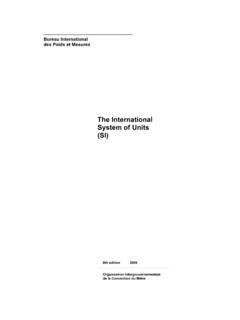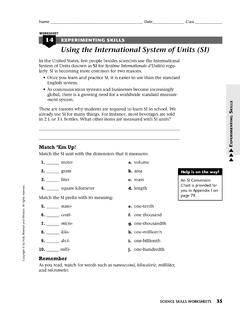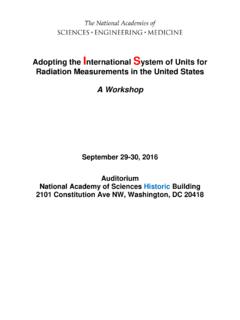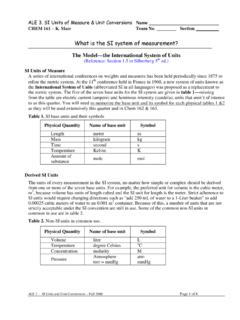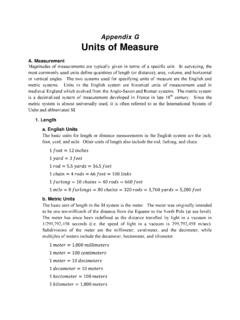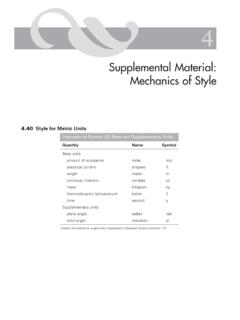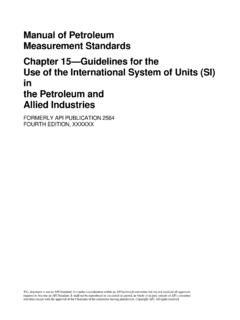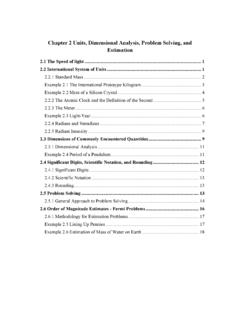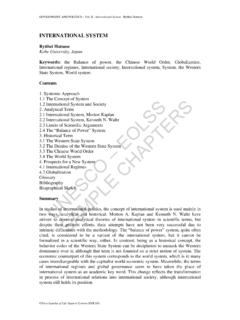Transcription of Chapter 2 The International System of Measuring Units (SI)
1 Chapter 2 The International System of Measuring Units (SI) SUMMARY The metric System is simple and easy to learn. Do not become confused with all the details given in this Chapter . You probably will not see most of the Units in practical use. You should, however, learn the most common Units for length, area, volume, mass, and temperature shown in Table 2-1. Prefixes are shown in Table 2-2. Preferred Units are shown in bold. How the metric Units relate to inch Units are covered in Chapter 17. See conversion program. TABLE 2-1 SI Units Quantity Symbol (Name) Prefix and Symbol* Other Metric unit nm (nanometer) = 10-9 m m (micrometer) = 10-6 m micron = m = mm mm (millimeter) = 10-3 m Length m cm (centimeter) = 10-2 m (meter) dm (decimeter) = 10-1 m hm (hectometer) = 102 m km (kilometer) = 103 m mm2 (square millimeter) = 10-6 m2 cm2 (square centimeter) = 10-4 m2 1 a (are) = 100 m2 Area m2 dm2 (square decimeter) = 10-2 m2 1 hm2 = 1 ha (hectare) = 10 000 m2 (square meter) hm2 (square hectometer)
2 = 104 m2 km2 (square kilometer) = 106 m2 mm3 (cubic millimeter) = 10-9 m3 1 L (microliter) = 1 mm3 Volume m3 cm3 (cubic centimeter) = 10-6 m3 1 mL (milliliter) = 1 cm3 (cubic meter) dm3 (cubic decimeter) = 10-3 m3 1 L (liter) = 1 dm3 1 kL (kiloliter) = 1 m3 g (microgram) = 10-9 kg Mass of water; mg (milligram) = 10-6 kg 1 mg = 1 L = 1 mm3 Mass(1) kg g (gram) = 10-3 kg 1 g = 1 mL = 1 cm3 (kilogram) Mg (megagram) = 103 kg 1 kg = 1 L = 1 dm3 1 Mg = 1 kL = 1 m3 1 tmetric = 1000 kg K The absolute temperature oC (degree Celsius) Temperature (kelvin) TK = TO + tC = + oC m/s 1 km/h = 1 m/s Speed (meter per second) m/s2 Acceleration (meter per second squared) N (micronewton) = 10-6 N mN (millinewton) = 10-3 N See NOTE (1) for Mass Force N daN (dekanewton) = 10 N(2) (newton) kN (kilonewton)
3 = 103 N MN (meganewton) = 106 N TABLE 2-1 SI Units (CONT D) Quantity Symbol (Name) Prefix and Symbol* Other Metric unit N m (micronewton x meter) = 10-6 N m Torque N m mN m (millinewton x meter) = 10-3 N m kN m (kilonewton x meter) = 103 N m MN m (meganewton x meter) = 106 N m Pa (micropascal) = 10-6 N/m2 Pressure, Pa mPa (millipascal) = 10-3 N/m2 1 mbar (millibar) = 100 Pa Stress (pascal = N/m2) kPa (kilopascal) = 103 N/m2 1 bar = 100 kPa MPa (megapascal) = 106 N/m2 10 bar = 1 MPa = 1 N/mm2 GPa (gigapascal) = 109 N/m2 mJ (millijoule) = 10-3 J Energy, J kJ (kilojoule) = 103 J 1 kWh (kilowatthour) = Work, Heat (joule) MJ (megajoule) = 106 J 1000 W x 3600 s = 106 J = MJ GJ (gigajoule) = 109 J W (microwatt) 10-6 W Power W mW (milliwatt) 10-3 W 1 W = 1 J/s = 1 N m/s (watt = J/s = N m/s) kW (kilowatt) 103 W metric horsepower, MW (megawatt) 106 W 1 hpmetric = 75 kgf m/s = 735 W GW (gigawatt) 109 W Notes: *Preferred in bold 1.
4 In the metric System there are separate distinct Units for mass and force. The kilogram is restricted to mass. The newton is the unit of force and should be used in place of the kilogram-force. The newton instead of the kilogram-force should be used in combination Units which include force, for example, pressure or stress (N/m2 = Pa), energy (N m = J), and power (N m/s = W). Considerable confusion exist in the use of the term mass and weight. Mass is the property of matter to which it owes its inertia. If a body at rest on the earth s surface is released from the forces holding it at rest, it will experience the acceleration of free fall (acceleration of gravity, g). The force required to restrain it against free fall is commonly called weight.
5 The acceleration of free fall varies in time and space, and weight is proportional to it. While at any point in time and space, weight can therefore vary, mass does not. Observed g can differ by over between various points on the earth s surface. Therefore, the difference of local g from the agreed standard value, m/s2, must be taken into account for precise measurements where g is involved, such as delicate weigh The term mass should be used to indicate the quantity of matter in an object. The term weight is commonly used where the technically correct word is mass. Because of this widespread nontechnical use, the word weight should be avoided in technical reports. In converting quantities that has been presented as weight, care must be taken to determine whether force or mass is intended.
6 2. The dekanewton has some usage in EU since 1 daN = kg (force). Units and symbols SI prefixes The prefixes listed in Table 2-2 are used to form names and symbols of the decimal multiples and submultiples of the SI Units . These prefixes or their symbols are attached to names or symbols of Units , forming what are properly called multiples and submultiples of metric Units . For recommended application of prefixes, see Table 2-1 TABLE 2-2 SI PREFIXES SI prefix name Symbol Multiplication factor yotta Y 1024 zetta Z 1021 exa E 1018 peta P 1015 tera T 1012 giga G 109 mega M 106 kilo k 103 = 1000 = E+03 hecto h 102 = 100 = E+02 deka da 101 = 10 = E+01 deci d 10-1 = = E-01 centi c 10-2 = = E-02 milli m 10-3 = = E-03 micro 10-6 nano n 10-9 pico p 10-12 femto f 10-15 atto a 10-18 zepto z 10-21 yocto y 10-24 Classes of Units The metric Units are divided into two classes: base Units and derived Units .
7 See definitions. Base Units The metric System is built upon the seven well-defined base Units of Table 2-3, which by convention are regarded as independent. Note that throughout this publication the word quantity means a measurable attribute of a phenomenon or of matter. TABLE 2-3 SI BASE Units (ANSI SI 10) Quantity unit Symbol length meter m mass kilogram kg time second s electric current ampere A thermodynamic temperature* kelvin K amount of substance mole mol luminous intensity candela cd *See Temperature on Derived Units Derived SI Units are shown in Table 2-4.
8 Those SI derived Units that have special names and symbols are listed in Table 2-5 and 6. Derived Units are formed by combining base Units according to the algebraic relations linking the corresponding quantities. The symbols for derived Units are obtained by means of the mathematical signs for multiplication, division, and use of exponents. For example, the SI unit for speed is the meter per second (m/s or m s-1) and that for density is kilogram per cubic meter (kg/m3 or kg m-3). TABLE 2-4 SI DERIVED Units WITH SPECIAL NAMES AND SYMBOLS (ANSI SI 10) Expression in terms Quantity SI unit Name Symbol of other SI Units angle, plane radian* rad m/m = 1 angle, solid steradian* sr m2/m2 = 1 Celsius temperature** degree Celsius oC K electric capacitance farad F C/V electric charge, quantity of electricity coulomb C A s electric conductance siemens S A/V electric inductance henry H Wb/A electric potential difference, electromotive forcevolt V W/A electric resistance ohm V/A energy, work.
9 Quantity of heat joule J N m force newton N kg m/s2 frequency (of a periodic phenomenon) hertz Hz 1/s illuminance lux lx lm/m2 luminous flux lumen lm cd sr magnetic flux weber Wb V s magneric flux density tesla T Wb/m2 power, radiant flux watt W J/s pressure, stress pascal Pa N/m2 NOTES: *See last paragraph of History on **See Temperature on It is frequently advantageous to express derived Units in terms of other derived Units with special names; for example, the metric unit for surface tension is usually expressed as N/m instead of kg/s2 and that for electric dipole moment is usually expressed as C m instead of A s m.
10 TABLE 2-5 SI DERIVED Units WITH SPECIAL NAMES FOR HUMAN HEALTH (ANSI SI 10) SI unit Quantity Name Symbol Expression in terms of other SI Units activity (of a radionuclide) becquerel Bq 1/s absorbed dose, specific energy imparted gray Gy J/kg kerma, absorbed dose index dose equivalent, dose equivalent index sievert Sv J/kg TABLE 2-6 SI DERIVED Units WITHOUT SPECIAL NAMES (ANSI SI 10) SI unit Quantity Name Symbol absorbed dose rate gray per second Gy/s acceleration meter per second squared m/s2 angular acceleration radian per second squared rad/s2 angular velocity radian per second rad/s area square meter m2 concentration (of amount of substance) mole per cubic meter mol/m3 current density ampere per square meter A/m2 density (mass density)
